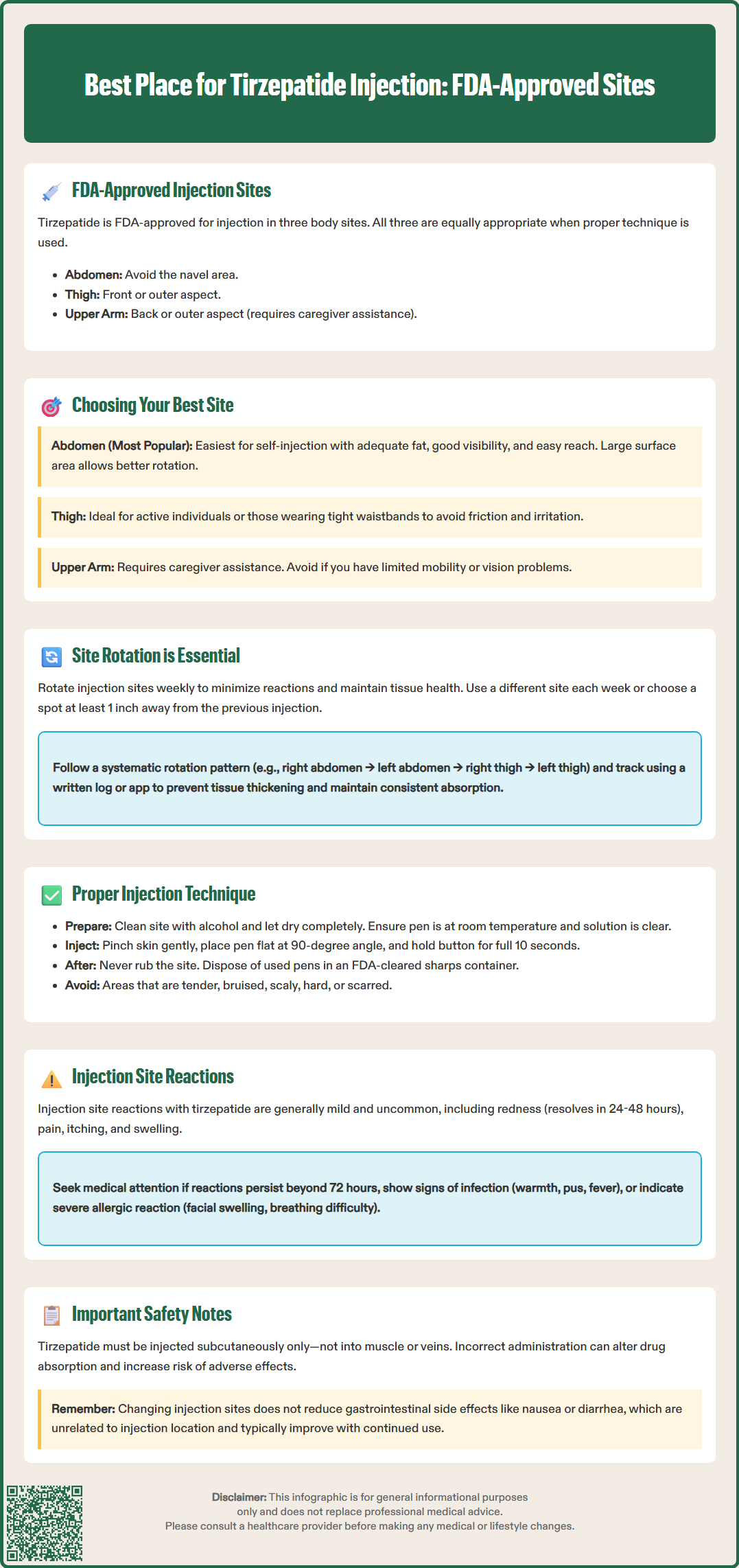LOSE WEIGHT WITH MEDICAL SUPPORT — BUILT FOR MEN
- Your personalised programme is built around medical care, not willpower.
- No generic diets. No guesswork.
- Just science-backed results and expert support.
Find out if you’re eligible

The best place for tirzepatide injection depends on individual patient factors, but the FDA approves three sites: the abdomen, thigh, and upper arm. Tirzepatide (Mounjaro, Zepbound) is a once-weekly subcutaneous injection for type 2 diabetes and chronic weight management. All three approved sites are equally appropriate when proper technique is used. The abdomen often provides the easiest access for self-injection, while the thigh offers a large surface area for rotation. Upper arm injections require caregiver assistance. Systematic site rotation is essential for maintaining tissue integrity and optimal medication absorption throughout long-term treatment.
Quick Answer: The FDA approves three equally appropriate sites for tirzepatide injection: the abdomen, thigh, and upper arm, with selection based on patient preference and practical considerations.
Tirzepatide (Mounjaro, Zepbound) is a once-weekly subcutaneous injection approved by the FDA for type 2 diabetes management and chronic weight management. The FDA-approved prescribing information specifies three anatomical sites for subcutaneous administration: the abdomen, thigh, and upper arm. These sites are selected based on adequate subcutaneous tissue depth, ease of access, and established safety profiles from clinical trials.
The abdomen is often considered an accessible site for self-injection, generally avoiding the area around the navel. The thigh (front or outer aspect) provides a large surface area and is particularly useful for patients who prefer sitting during injection. The upper arm (back or outer aspect) should be administered by a caregiver, as specified in the Instructions for Use.
All three sites are appropriate for tirzepatide administration when proper technique is used. The choice among these sites is primarily based on patient preference, comfort, and practical considerations. Healthcare providers should educate patients on the importance of rotating injection sites to help minimize injection site reactions and maintain tissue integrity over long-term treatment. According to the Instructions for Use, patients should use a different site each week, and if using the same body area, choose a spot at least 1 inch away from the previous injection.
It is important to note that tirzepatide must be administered subcutaneously—not intramuscularly or intravenously. Injection into muscle tissue or blood vessels can alter drug absorption and increase the risk of adverse effects. Patients should receive proper training on identifying subcutaneous tissue and using correct injection technique.
Selecting the optimal injection site for tirzepatide involves considering several patient-specific factors including body composition, manual dexterity, lifestyle, and previous injection experience. While all FDA-approved sites are equally appropriate, individual circumstances may make one location more practical or comfortable than others.
Patient factors to consider:
Body composition and subcutaneous fat distribution – Patients with limited subcutaneous tissue in certain areas may find other sites more suitable. Many patients find the abdomen easiest for self-injection due to its typically adequate subcutaneous fat in most adults.
Manual dexterity and vision – The abdomen offers good visibility and easier reach for self-injection. Patients with arthritis, limited shoulder mobility, or visual impairment may struggle with thigh or upper arm injections.
Lifestyle and clothing – Active individuals or those who wear tight waistbands may prefer thigh injections to avoid abdominal site irritation from clothing friction.
Previous injection site reactions – If a patient experiences persistent injection site reactions (redness, itching, or induration) at one location, switching to an alternative approved site is appropriate.
For patients new to injectable medications, abdominal injections often provide an easier learning experience. The abdomen's large surface area allows for extensive site rotation within a single anatomical region, which is particularly valuable for weekly injections over months or years. Remember that upper arm injections should be administered by a caregiver, per the Instructions for Use.
Healthcare providers should assess each patient's physical capabilities and preferences during initial training to establish a sustainable injection routine. Patients should not inject into areas that are tender, bruised, scaly, hard, or scarred, as noted in the product labeling.

Correct injection technique is essential for ensuring optimal tirzepatide absorption, minimizing discomfort, and preventing injection site complications. The medication comes in a single-dose prefilled pen designed for subcutaneous administration, and proper technique involves several critical steps.
Step-by-step injection technique:
Site preparation – Clean the chosen injection site with an alcohol swab and allow the skin to dry completely. Never inject through clothing.
Pen preparation – Allow the pen to reach room temperature before injection, which may reduce injection discomfort. Inspect the solution, which should be clear and colorless to slightly yellow. Do not use if cloudy, discolored, or contains particles.
Skin pinching – Gently pinch a fold of skin to ensure subcutaneous injection. This is particularly important in lean patients.
Injection angle – Place the pen flat against the skin at a 90-degree angle as directed in the Instructions for Use.
Administration – Press the pen button and hold for the full time specified in the Instructions for Use (typically 10 seconds) until the dose is complete, as indicated by the pen's dose indicator window.
Site rotation strategy:
Systematic site rotation is crucial for preventing lipohypertrophy (tissue thickening) and maintaining consistent absorption. According to the product labeling, patients should rotate injection sites with each weekly dose. If using the same body area, inject at least 1 inch away from the previous injection site. A practical rotation pattern might involve: Week 1 (right abdomen), Week 2 (left abdomen), Week 3 (right thigh), Week 4 (left thigh), then repeating. Maintaining a written log or using a smartphone app can help track rotation patterns.
Patients should never inject into areas with visible skin changes, bruising, scarring, or active skin conditions. After injection, do not rub the injection site. Always dispose of used pens in an FDA-cleared sharps container. If injection site reactions persist despite proper rotation, consultation with a healthcare provider is warranted to assess technique and consider alternative management strategies.
Injection site reactions with tirzepatide are generally mild and uncommon. According to the FDA-approved prescribing information, these local reactions can occur with subcutaneous administration. Patients should be aware of potential injection site reactions regardless of which approved site they use (abdomen, thigh, or upper arm).
Typical injection site reactions include:
Mild erythema (redness) – Usually resolves within 24-48 hours
Transient pain or tenderness – Most common immediately after injection
Pruritus (itching) – Typically mild and self-limiting
Induration or swelling – May indicate improper injection depth
These local reactions are generally related to injection technique, inadequate site rotation, or individual tissue sensitivity. Some patients may report subjective differences in comfort levels among sites, though this varies by individual.
When to seek medical attention:
Patients should contact their healthcare provider if they experience persistent injection site reactions lasting more than 72 hours, signs of infection (increasing warmth, purulent drainage, fever), or signs of severe allergic reactions (rash, hives, swelling of face/throat, difficulty breathing). Severe hypersensitivity reactions require immediate medical attention, as noted in the Medication Guide.
It is important to distinguish injection site reactions from tirzepatide's systemic gastrointestinal side effects (nausea, vomiting, diarrhea), which are unrelated to injection location and represent the medication's most common adverse effects overall. Gastrointestinal symptoms typically improve with continued use and are not influenced by changing injection sites. Proper patient education should emphasize that injection site selection does not impact the likelihood or severity of these systemic effects.
No, you should rotate injection sites with each weekly dose. If using the same body area, inject at least 1 inch away from the previous injection site to prevent tissue complications and maintain consistent absorption.
All three FDA-approved sites (abdomen, thigh, upper arm) are equally appropriate. The abdomen often provides easier access for self-injection, but the best site depends on individual factors including body composition, manual dexterity, and personal comfort.
No, according to the Instructions for Use, upper arm injections should be administered by a caregiver. The abdomen and thigh are appropriate sites for self-injection.
All medical content on this blog is created using reputable, evidence-based sources and is regularly reviewed for accuracy and relevance. While we strive to keep our content current with the latest research and clinical guidelines, it is intended for general informational purposes only.
This content is not a substitute for professional medical advice, diagnosis, or treatment. Always consult a licensed healthcare provider with any medical questions or concerns. Use of this information is at your own risk, and we are not liable for any outcomes resulting from its use.